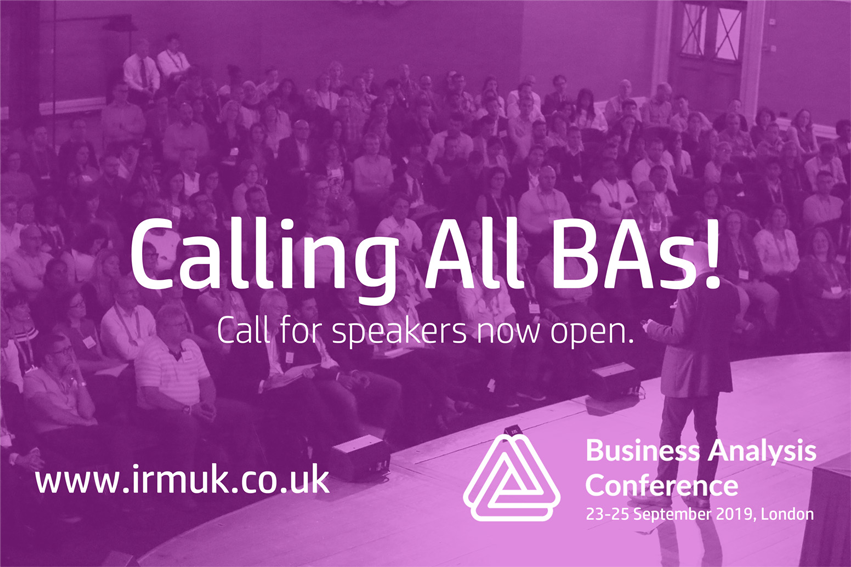For the last seven years I have spoken at the BA Europe Conference in London and it’s fair to say it has changed my life. It has provided me with many opportunities that I would not have got otherwise in terms of networking and the chance to contribute to the development of the Business Analysis profession in general. It’s certainly something I would recommend if you think you are ready for it; it’s a friendly atmosphere and every effort is made to help you succeed. To this end I thought I would put together some advice to assist any of you who are stepping up to volunteer for the first time. I will attempt to put the advice in the chronological order of the process you go through….
 David Beckham, Senior Business Analyst, Aviva; david.beckham@aviva.com
David Beckham, Senior Business Analyst, Aviva; david.beckham@aviva.com
David is a member of the Business Analysis Conference Europe Advisory Board.
The next Business Analysis Conference Europe will take place 21-23 September 2020, London
View the other entries in this blog series: Part 1, Part 2, Part 3, Part 4, Part 5
It’s submission time!
Once the call for speakers has gone out it’s time to consider your submission (this has now been published – click here for guidelines and to apply online). If you are a first-time speaker then I strongly recommend carefully reading the advice for speakers that IRM publishes every year. I always review this to check nothing has changed then basically the process I go through is as follows:
What are the conference tracks this year? This can be found in the e-mail issued by IRM to previous delegates or via their website; www.irmuk.co.uk. Once I’ve checked this out I then consider whether I have any material already that fits or whether any of the tracks offer any inspiration. If I have material already it makes the whole thing a bit easier but I’ll treat this as if I’m writing a submission from scratch. In this eventuality the next thing I ask myself is “do I have a story to tell?” My way of working this through is to work backwards from the punchline, or the message I wish to leave in the minds of the audience and then figure out the important components at a high level. Remember you don’t need the whole story at this juncture, but just enough to put together a summary of your talk and the key outcomes and learning points for the submission. It is important at this stage to be concise and remember the guidelines in terms of not letting your submission become an advert or your life story. Essentially, your submission allows you to really distil the essence of the presentation you will ultimately produce and present and should be looked upon as an opportunity to crystallise your thoughts and get useful feedback from the advisory board.
If your submission is unsuccessful, do not be too discouraged. The advisory board receives many more submissions than there are available slots on the conference programme and this means there are always going to be some people who are disappointed. It may also be that you have chosen a topic that is well represented in terms of the number of submissions so you have unfortunately narrowed your chances of success; whatever the reason for the advisory board declining your submission do not be disheartened or put off from trying again. In fact, seek out other opportunities; is there an IIBA event you could speak at? Or another IRM Conference? Or something within your own organisation? If you have come this far and believe you have something to say then it would be a shame not to pursue that desire….!
If your submission is successful, then the fun really begins! You will be asked to submit a one page summary outlining the storyline of your presentation to ensure that the key messages of your online submission are reflected in this. On the synopsis you will be asked to indicate your speaking experience – don’t worry if you don’t have much experience as the Advisory Board track leaders will be very supportive of you. Once this has been accepted it is now time to work on the construction of your presentation and again, I suggest you refer to the speaker guidelines mentioned already which will give you plenty of ideas and guidance on the practical formatting of your eventual presentation deck. However, there is more to it than that! In my experience successful presentation has to have a clear and compelling story and it is here that I recommend you concentrate your initial efforts. Consider your audience’s knowledge and experience of your topic before you begin your presentation; what do they know? What do they think they know? By understanding this you will be able to create a clear narrative to allow them to improve their knowledge, increase their understanding, or maybe consider and agree with any argument or opinion you are putting forward. As a presenter or speaker you have to take the audience on a journey with you that will leave them either in a more enlightened or satisfied state at the end of that journey. You may even wish to leave them curious to know more so you have acted as a catalyst for their learning. But, to do so it is essential to put yourself in their position and understand their point of view rather than assuming yours is the correct one.
Once you have the beginnings of your narrative you can then start planning it out step-by-step or even slide by slide. You may do this on post-it notes, a good old-fashioned process model, or even the slide planner aspect of PowerPoint; either way you will start to construct a storyline or through line as it’s known around which you can build the rest of your deck. (I am assuming that you will be using PowerPoint as a standard presentation tool but if not most of the principles I will talk about will transfer to other media. If you are using non-standard software it is worth checking with the events team as to compatibility requirements et cetera.)
In terms of your actual presentation there are numerous books available on presentation styles and formats and I strongly urge you to read anything by Chris Anderson or Carmine Gallo regarding TED presentations as they contain a mine of information that will add huge value to your presentation and your experience of the event. ‘Resonate’ by Nancy Duarte is also an excellent read. For those of you intending to submit a proposal or those just planning a presentation these books are brilliant homework!
It is my intention to return to this topic over the next few months as we build towards the BA Europe Conference in September. I am intending to submit a proposal and I shall use this as a case study. I will also discuss how to manage your nerves before (and during) the event and also pass on some hints and tips around personal style plus the logistics of presenting at conferences such as using microphones, working with the events team etc.
Hopefully those of you planning a presentation will find it useful and there’ll be interesting stuff for those who aren’t!
View the second blog in this series, ‘Unaccustomed As I Am To Public Speaking Part 2‘.
David Beckham has spent his career working in Financial Services, initially at Norwich Union then subsequently with Aviva. He was a founder member of the Business Analysis Practice when it was formed within Aviva IT and has had two terms as the Practice Lead. He has worked on numerous large change programmes and has been heavily involved in building the capability of Business Analysis within the organisation over the last decade. He has presented at the European BA Conference on a regular basis and has had several articles published on Business Analysis topics. Despite being diagnosed with Parkinson’s Disease in 2010 at the age of 43 David continues to relish his role as a Business Analyst and is a passionate advocate of the profession and the benefits it gives to organisations everywhere. Since his diagnosis David has been developing a series of seminars focussing on his recent experiences and regularly speaks on the positive power of change both on a professional and personal basis.
Copyright David Beckham, Senior Business Analyst, Aviva


